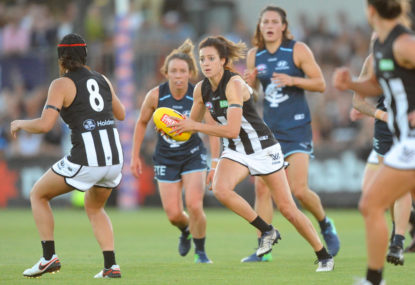Round 1 of the inaugural AFL Women’s competition burst onto the scene more explosively than Patrick Dangerfield out of pack.
It was eye-catching, impressive, and for many, an unexpected success.
With over 50,000 spectators attending the first four matches – the last almost called off due to lightning strikes – the sporting community overwhelmingly deemed this long awaited competition a win for women and a win for Australian rules football.
In the dead sporting month of February, where we would otherwise have the tedious men’s pre-season competition, the AFL have done well to design what appears to be a long-term substitute.
AFL CEO Gillon McLachlan would have been chipping at his fingernails in the days leading up to Friday night’s match at Princes Park, although he found himself faced with a positive conundrum when he confronted hundreds of fans who were denied entry on the basis of it being at full capacity.
Inside Carlton’s historical old stomping ground, it was a new hero, Darcy Vescio, who stole the headlines with a game-high four goals. The match itself provided spectators with a ruthless contest which some have likened to the way footy used to be in the 80s: tough.
However, when the dust settles after what was nothing short of a triumphant weekend, the competition will soon be open to vehement criticism.

From the perspective of the AFLW, it was heavily advantageous that the generic football community has been mostly unexposed to women playing football prior to Friday night.
This is a blemish on behalf of the media, failing to create hype surrounding women playing football, as well as a flaw at grassroots level where women’s football is far from ubiquitous.
In the lead up to Friday night there was no preamble, no trailer. For many, it was like an unexpected pregnancy: a bundle of fresh joy out of the oven without warning.
Sadly, due to a lack of exposure of women playing football, and of women playing sport for that matter, the bar was set so low for so many, that onlookers became pleasantly surprised when they realised they were just watching footy.
This has worked in favour for the AFLW in the first week, and may do so for the remainder of the season. But, because the competition was fast-tracked and came unexpectedly for many spectators, women’s football has opened itself up to an onslaught of inevitable criticism following the honeymoon period.
A few points of criticism foreshadowed.
1. The AFL is a not-for-profit organisation. They need to raise money to sustain the growth of the league. Attendance numbers will rapidly decline when patrons are charged for entry; it is a natural deterrent.
2. The gap between the best players and those less experienced will become more pronounced as the competition progresses. Feats of the elites will continue to be celebrated but those with a poverty of skill will be exposed.
The headline can already be envisaged: Melbourne look to rebuild for 2018.
3. What is this, soccer? The losing team in each of the first four matches only managed one goal each. This is a problem that the men’s competition has faced in recent times, but not to this extent.
4. AFLW is swimming in skill errors. Dropped chest marks, missed targets and poor decision-making were evident over the weekend but forgiven due to the youth of the league. It won’t be forgiven for long.
Another red flag for the competition is that the standard will grow in the coming weeks, before plateauing. Individually, players will acquire a stronger game sense, and so instinct-based play will become classier.
Teams will also learn to trust each other as camaraderie builds, and that will inevitably lift the standard. We must remember that Round 1 was the first time some of these teams had played a match together, and also the first time some players had carried out a full match of Aussie rules.
As the standard grows, so will expectations. As expectations grow, so will criticism.
It is the reality that spectators were so overwhelmingly impressed by the quality of football from a gender that has been hidden from sight on the football field for decades.
Commentators have warned critics to remember that the AFLW is not the AFL. They are different competitions and are different games in many ways. The AFLW is not dissimilar to an adolescent finding its feet and discovering their identity. It does not know exactly who it is yet, and it might be some time before it does.
Australians are notorious for becoming frustrated at individuals who do not reach their potential: Shane Watson, Jack Watts and James Magnussen, just to name a few. This competition will be no exception to keyboard warriors.
It is the responsibility of both the AFL and the media to remind the public that AFLW should be judged entirely on its own merit, mutually exclusive to the men’s competition.
The AFLW is not the same person as her older brother. Her older brother has been known as the most popular and talented kid in high school for years.
Now the younger sister has arrived, and people took a liking to her upon first impressions. But teachers and friends need to be reminded that these siblings, although alike, have different talents and different personalities.
We are yet to find out exactly where these differences lie, and the public must remain patient and not succumb to negativity before we do.































































































